Utilizing Infrared Thermometry to Assess the Crop Water Stress Index of Wheat Genotypes in Arid Regions under Varying Irrigation Regimes
Abstract
:1. Introduction
2. Materials and Methods
2.1. Experimental Layout
2.2. Plant Materials
2.3. Irrigation Requirement Consumption and Water Supply
2.4. Time of Irrigation
- Treatment for no stress: intervals of irrigation based on the pan factor (Ef = 0.8). This means near irrigation intervals (after collecting 53 mm from the evaporation pan);
- Treatment for stress: intervals of irrigation according to the pan factor (Ef = 0.4). This means far irrigation intervals (after collecting 107 mm from the evaporation pan).
2.5. Applied Water
2.6. Water Use Efficiency (WUE)
2.7. Upper and Lower Baselines and CWSI Measurement
3. Results and Discussion
3.1. Irrigation Requirements (Applied Water)
3.2. Wheat Genotypes (CWSI)
3.3. Upper and Lower Baseline Evaluation
3.4. CWSI before and after Supplying Irrigation Water
3.5. Monthly Variations in CWSI
3.6. CWSI and Grain Yield (GY)
3.7. CWSI and WUE
4. Conclusions
Supplementary Materials
Author Contributions
Funding
Data Availability Statement
Acknowledgments
Conflicts of Interest
References
- Temirbekova, S.K.; Kulikov, I.M.; Afanasyeva, Y.V.; Ashirbekov, M.Z.; Beloshapkina, O.O.; Kalashnikova, E.A.; Sardarova, I.; Begeulov, M.S.; Kucher, D.E.; Ionova, N.E.; et al. The Biological Traumatization of Crops Due to the Enzyme Stage of Enzyme-Mycotic Seed Depletion. Pathogens 2022, 11, 376. [Google Scholar] [CrossRef]
- Giura, A.; Saulescu, N. Chromosomal location of genes controlling grain size in a large grained selection of wheat (Triticum aestivum L.). Euphytica 1996, 89, 77–80. [Google Scholar] [CrossRef]
- Khedr, R.A.; Sorour, S.G.R.; Aboukhadrah, S.H.; El Shafey, N.M.; Abd Elsalam, H.E.; El-Sharnouby, M.E.; El-Tahan, A.M. Alleviation of salinity stress effects on agro-physiological traits of wheat by auxin, glycine betaine, and soil additives. Saudi J. Biol. Sci. 2022, 29, 534–540. [Google Scholar] [CrossRef]
- Ning, D.; Zhang, Y.; Li, X.; Qin, A.; Huang, C.; Fu, Y.; Gao, Y.; Duan, A.J.P. The effects of foliar supplementation of silicon on physiological and biochemical responses of winter wheat to drought stress during different growth stages. Plants 2023, 12, 2386. [Google Scholar] [CrossRef]
- Pang, Z.; Tayyab, M.; Islam, W.; Tarin, M.; Sarfaraz, R.; Naveed, H.; Zaman, S.; Zhang, B.; Yuan, Z.; Zhang, H. Silicon mediated improvement in tolerance of economically important crops under drought stress. Appl. Ecol. Environ. Res. 2019, 17, 6151–6170. [Google Scholar] [CrossRef]
- Snehalatha, D.; Bharghavi, J.; Rao, P.R.; Srikanth, B.; Kumar, C.; Ramesh, T.; Change, C. Silicon Improved Water Stress Tolerance in Rice Genotypes. Int. J. Environ. Clim. Change 2023, 13, 2056–2068. [Google Scholar] [CrossRef]
- Sousa, L.; Brito, A.; Souza, L.; Teixeira, K.; Nascimento, V.; Albuquerque, G.; Oliveira, C.; Okumura, R.; Nogueira, G.; Freitas, J. Does silicon attenuate PEG 6000-induced water deficit in germination and growth initial the seedlings corn. Braz. J. Biol. 2023, 83, e265991. [Google Scholar] [CrossRef]
- FAOSTAT. Food. In Crops and Livestock Products; Agriculture Organization of the United Nations: Rome, Italy, 2022. [Google Scholar]
- Reynolds, M.P. Climate Change and Crop Production; Cabi: Oxon, UK, 2010. [Google Scholar]
- Guo, L.; Ma, L.; Jiang, H.; Zeng, D.; Hu, J.; Wu, L.; Gao, Z.; Zhang, G.; Qian, Q.J. Genetic analysis and fine mapping of two genes for grain shape and weight in rice. J. Integr. Plant Biol. 2009, 51, 45–51. [Google Scholar] [CrossRef] [PubMed]
- Gorinstein, S.; Lojek, A.; Číž, M.; Pawelzik, E.; Delgado-Licon, E.; Medina, O.J.; Moreno, M.; Salas, I.A.; Goshev, I. Comparison of composition and antioxidant capacity of some cereals and pseudocereals. Int. J. Food Sci. Technol. 2008, 43, 629–637. [Google Scholar] [CrossRef]
- Tsao, R. Carotenoid, tocopherol, lignan, flavonoid, and phytosterol compositions of wheat grain and its fractions. Wheat Antioxid. 2007, 4, 42–53. [Google Scholar]
- Abdalla, A.; Stellmacher, T.; Becker, M. Trends and prospects of change in wheat self-sufficiency in Egypt. Agriculture 2022, 13, 7. [Google Scholar] [CrossRef]
- McGill, J.; Prikhodko, D.; Sterk, B.; Talks, P. Egypt: Wheat Sector Review; FAO: Rome, Italy, 2015. [Google Scholar]
- Salevurakis, J.W.; Abdel-Haleim, S.M. Bread subsidies in Egypt: Choosing social stability or fiscal responsibility. Rev. Radic. Political Econ. 2008, 40, 35–49. [Google Scholar] [CrossRef]
- Tellioglu, I.; Konandreas, P. Agricultural Policies, Trade and Sustainable Development in Egypt; FAO: Rome, Italy, 2017. [Google Scholar]
- Mohamed, N.E.; Bedawy, I.M.; Hefny, Y.A. Diallel Analysis for Area, Chlorophyll and Temperature of Flag Leaf in Bread Wheat under Well Watered and Drought Stress Conditions. J. Agric. Sci. 2021, 13, 10. [Google Scholar] [CrossRef]
- Shalaby, M.; Al-Zahrani, K.; Baig, M.; Straquadine, G.; Aldosari, F.; Sciences, P. Threats and challenges to sustainable agriculture and rural development in Egypt: Implications for agricultural extension. J. Anim. Plant Sci. 2011, 21, 581–588. [Google Scholar]
- Temirbekova, S.K.; Kulikov, I.M.; Ashirbekov, M.Z.; Afanasyeva, Y.V.; Beloshapkina, O.O.; Tyryshkin, L.G.; Zuev, E.V.; Kirakosyan, R.N.; Glinushkin, A.P.; Potapova, E.S.; et al. Evaluation of Wheat Resistance to Snow Mold Caused by Microdochium nivale (Fr) Samuels and I.C. Hallett under Abiotic Stress Influence in the Central Non-Black Earth Region of Russia. Plants 2022, 11, 699. [Google Scholar] [CrossRef]
- Raghib Bakheit Alwafy, B.; Ali, M.; Abdel-Moneim El-Morsidy, M. Assessment of Bread Wheat Genotypes Under Normal Irrigation and Water Stress. Assiut J. Agric. Sci. 2020, 51, 42–65. [Google Scholar]
- Mirbahar, A.A.; Markhand, G.; Mahar, A.; Abro, S.A.; Kanhar, N.A. Effect of water stress on yield and yield components of wheat (Triticum aestivum L.) varieties. Pak. J. Bot. 2009, 41, 1303–1310. [Google Scholar]
- Clarke, J.M.; DePauw, R.M.; Townley-Smith, T.F. Evaluation of methods for quantification of drought tolerance in wheat. Crop Sci. 1992, 32, 723–728. [Google Scholar] [CrossRef]
- Nash, M.S.; Wickham, J.; Christensen, J.; Wade, T. Changes in landscape greenness and climatic factors over 25 years (1989–2013) in the USA. Remote Sens. 2017, 9, 295. [Google Scholar] [CrossRef] [PubMed]
- Rud, R.; Cohen, Y.; Alchanatis, V.; Levi, A.; Brikman, R.; Shenderey, C.; Heuer, B.; Markovitch, T.; Dar, Z.; Rosen, C. Crop water stress index derived from multi-year ground and aerial thermal images as an indicator of potato water status. Precis. Agric. 2014, 15, 273–289. [Google Scholar] [CrossRef]
- Kaçar, M. Investigation of Cotton Water Stress Index Variations under Different Water and Fertilizer Systems. 2007.Ç.Ü Fen Bilimleri Enstitüsü Yıl:2008 Cilt:19-2 in Turkish. Available online: https://fbe.cu.edu.tr/storage/fbeyedek/makaleler/200819-2-4.pdf (accessed on 14 August 2024).
- Sharda, V.; Srivastava, P.; Kalin, L.; Ingram, K.; Chelliah, M. Development of community Water Deficit Index: Drought-forecasting tool for small-to mid-size communities of the Southeastern United States. J. Hydrol. Eng. 2013, 18, 846–858. [Google Scholar] [CrossRef]
- Idso, S.; Jackson, R.; Pinter, P., Jr.; Reginato, R.; Hatfield, J. Normalizing the stress-degree-day parameter for environmental variability. Agric. Meteorol. 1981, 24, 45–55. [Google Scholar] [CrossRef]
- Allen, R.G.; Smith, M.; Pereira, L.S.; Raes, D.; Wright, J. Revised FAO procedures for calculating evapotranspiration: Irrigation and drainage paper no. 56 with testing in Idaho. In Watershed Management and Operations Management 2000; FAO: Rome, Italy, 2000; pp. 1–10. [Google Scholar]
- Klute, A. Methods of Soil Analysis: Chemical and Microbiological Properties; Wiley: New York, NY, USA, 1986. [Google Scholar]
- Doorenbos, J.; Pruitt, W. Crop water requirement: Food and agriculture organization of the United Nations. FAO Irrig. Drain. Pap. 1977, 24, 144. [Google Scholar]
- Monteith, J.; Unsworth, M.H. Principles of Environmental Physics, 2nd ed.; Butterworth-Heinemann, Elsevier: Oxford, UK, 1990. [Google Scholar]
- Ibrahim, M.M.; Abd El Fattah, N.G.; El-Mageed, A. Net Irrigation Water Requirements for Wheat in Egypt Under Climate Change Conditions. J. Soil Sci. Agric. Eng. 2020, 11, 385–393. [Google Scholar]
- Gontia, N.; Tiwari, K. Development of crop water stress index of wheat crop for scheduling irrigation using infrared thermometry. Agric. Water Manag. 2008, 95, 1144–1152. [Google Scholar] [CrossRef]
- Orta, A.H.; Erdem, T.; Erdem, Y. Determination of Water Stress Index in Sunflower/Determinación Del Indice De Estrés Hídrico Para Girasol/Détermination De L’index Du Stress Dû Au Manque D’humidité Pour Le Tournesol. Helia 2002, 25, 27–38. [Google Scholar] [CrossRef]
- Sneha, C.; Santhoshkumar, A.; Sunil, K. Quantifying water stress using crop water stress index in mahogany (Swietenia macrophylla King) seedlings. Curr. Sci. 2013, 104, 348–351. [Google Scholar]
- Emekli, Y.; Bastug, R.; Buyuktas, D.; Emekli, N.Y. Evaluation of a crop water stress index for irrigation scheduling of bermudagrass. Agric. Water Manag. 2007, 90, 205–212. [Google Scholar] [CrossRef]
- Irandoust, T.; Bijanzadeh, E. Effect of two irrigation regimes on crop water stress index and yield and yield components of Triticale (X Triticosecale wittmack) Cultivars. J. Plant Process Funct. 2018, 6, 15–22. [Google Scholar]
- Alghory, A.; Yazar, A. Evaluation of crop water stress index and leaf water potential for deficit irrigation management of sprinkler-irrigated wheat. Irrig. Sci. 2019, 37, 61–77. [Google Scholar]
- Bijanzadeh, E.; Barati, V.; Emam, Y.; Pessarakli, M. Assessment of the crop water stress index and color quality of bur clover (Medicago polymorpha L.) under different irrigation regimes. Commun. Soil Sci. Plant Anal. 2019, 50, 2825–2835. [Google Scholar] [CrossRef]
- Bijanzadeh, E.; Emam, Y. Evaluation of crop water stress index, canopy temperature and grain yield of five Iranian wheat cultivars under late season drought stress. J. Plant Physiol. Breed. 2012, 2, 23–33. [Google Scholar]
- Alderfasi, A.A.; Nielsen, D.C. Use of crop water stress index for monitoring water status and scheduling irrigation in wheat. Agric. Water Manag. 2001, 47, 69–75. [Google Scholar] [CrossRef]
- Bijanzadeh, E.; Naderi, R.; Emam, Y. Determination of crop water stress index for irrigation scheduling of turfgrass (Cynodon dactylon L. Pers.) under drought conditions. J. Plant Physiol. Breed. 2013, 3, 13–22. [Google Scholar]
- Al-Faraj, A.; Meyer, G.E.; Horst, G.L. A crop water stress index for tall fescue (Festuca arundinacea Schreb.) irrigation decision-making—A traditional method. Comput. Electron. Agric. 2001, 31, 107–124. [Google Scholar] [CrossRef]
- Jalali-Farahani, H.; Slack, D.C.; Kopec, D.M.; Matthias, A.D. Crop water stress index models for Bermudagrass turf: A comparison. Agron. J. 1993, 85, 1210–1217. [Google Scholar] [CrossRef]
- Baili, F.; Changfa, W.; Fang, M.; Songwu, Z.; Yongjie, H. Leaf gas exchange character of low canopy temperature wheat in drought conditions. J. Triticeae Crops 2001, 21, 48–51. [Google Scholar]
- Garrot, D.J., Jr.; Ottman, M.J.; Fangmeier, D.; Husman, S.H. Quantifying wheat water stress with the crop water stress index to schedule irrigations. Agron. J. 1994, 86, 195–199. [Google Scholar] [CrossRef]
- Kumar, N.; Poddar, A.; Shankar, V.; Ojha, C.S.P.; Adeloye, A. Crop water stress index for scheduling irrigation of Indian mustard (Brassica juncea) based on water use efficiency considerations. J. Agron. Crop Sci. 2020, 206, 148–159. [Google Scholar] [CrossRef]
- Bijanzadeh, E.; Moosavi, S.M.; Bahadori, F. Quantifying water stress of safflower (Carthamus tinctorius L.) cultivars by crop water stress index under different irrigation regimes. Heliyon 2022, 8, e09010. [Google Scholar] [CrossRef]
- Fattahi, K.; Babazadeh, H.; Najafi, P.; Sedghi, H. Scheduling maize irrigation based on Crop Water Stress Index (CWSI). Appl. Ecol. Environ. Res. 2018, 16, 7535–7549. [Google Scholar] [CrossRef]
- Kumar, V.; Sharma, A.; Kaur, P.; Kumar, R.; Keshavarzi, A.; Bhardwaj, R.; Thukral, A.K. Assessment of soil properties from catchment areas of Ravi and Beas rivers: A review. Geol. Ecol. Landsc. 2019, 3, 149–157. [Google Scholar] [CrossRef]
- Heydari, A.; Bijanzadeh, E.; Naderi, R.; Emam, Y. Quantifying water stress in canola (Brassica napus L.) using crop water stress index. Iran Agric. Res. 2019, 38, 1–8. [Google Scholar]
- Ahmadi, H.; Nasrolahi, A.H.; Sharifipour, M.; Isvand, H. Determination of soybean water stress index (CWSI) for irrigation management for maximum yield and water productivity. Irrig. Water Eng. 2018, 8, 121–131. [Google Scholar]
- Gardner, B.; Nielsen, D.; Shock, C. Infrared thermometry and the crop water stress index. II. Sampling procedures and interpretation. J. Prod. Agric. 1992, 5, 466–475. [Google Scholar] [CrossRef]
- Orta, A.H.; Başer, İ.; Şehirali, S.; Erdem, T.; Erdem, Y. Use of infrared thermometry for developing baseline equations and scheduling irrigation in wheat. Cereal Res. Commun. 2004, 32, 363–370. [Google Scholar] [CrossRef]
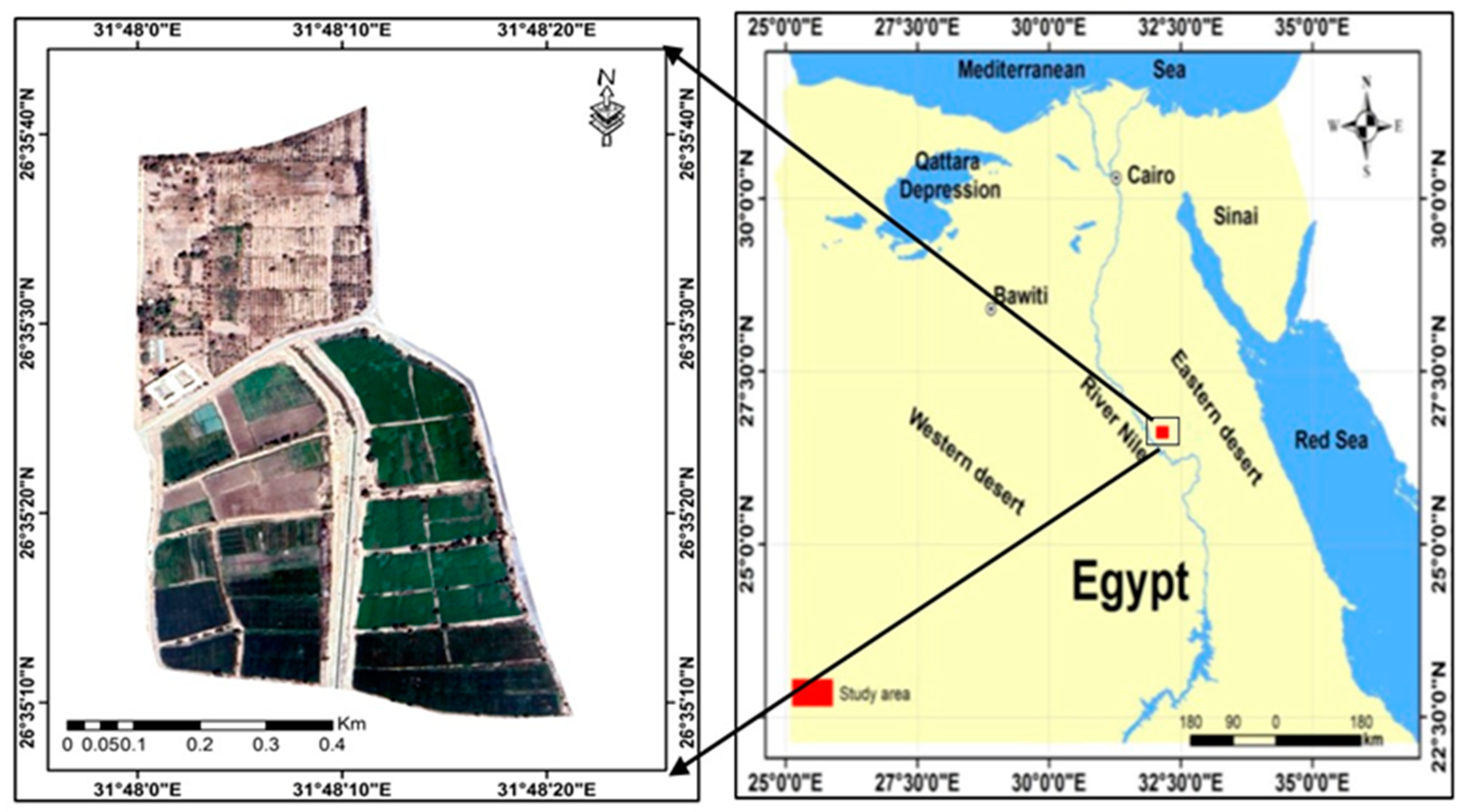
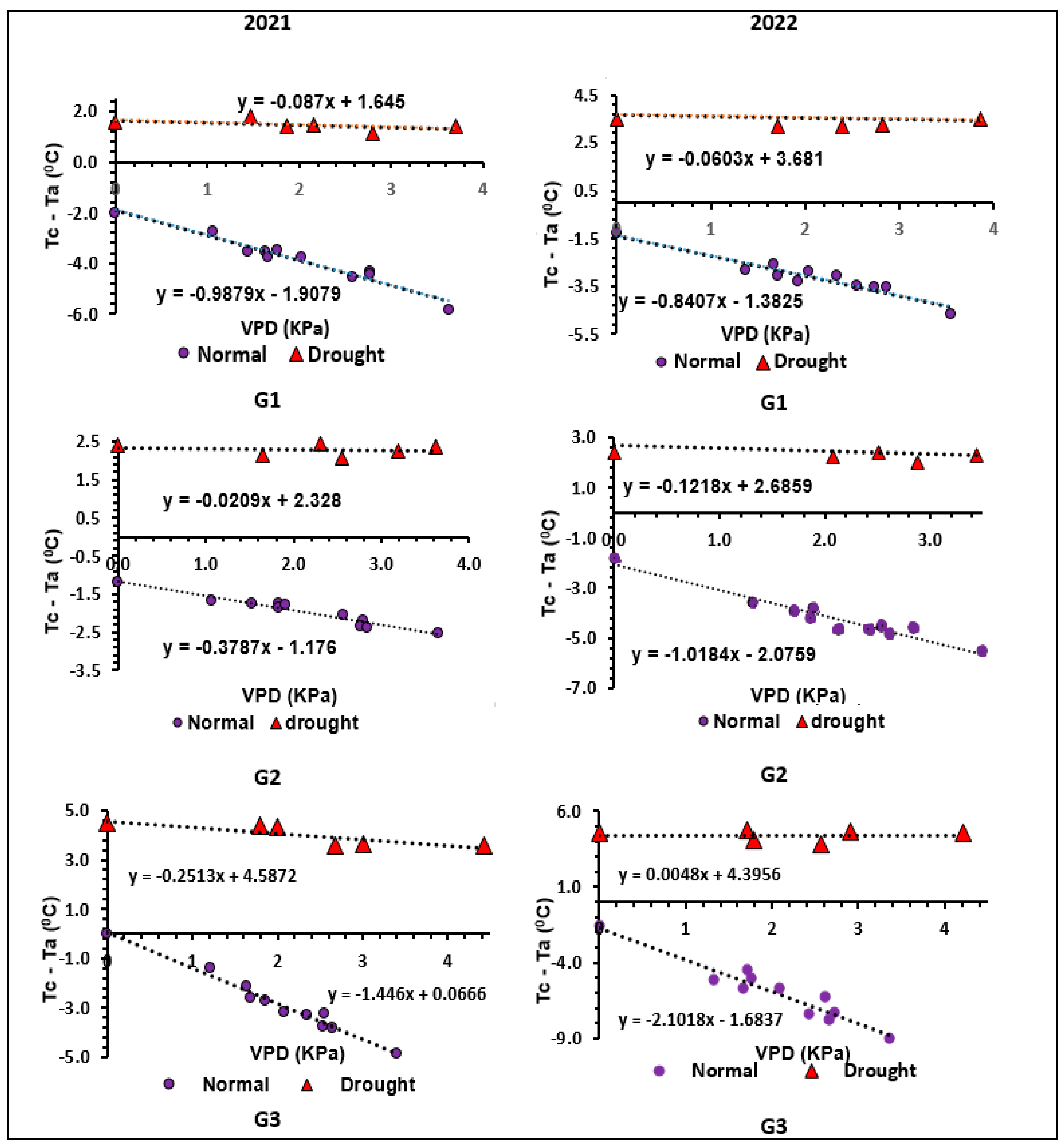
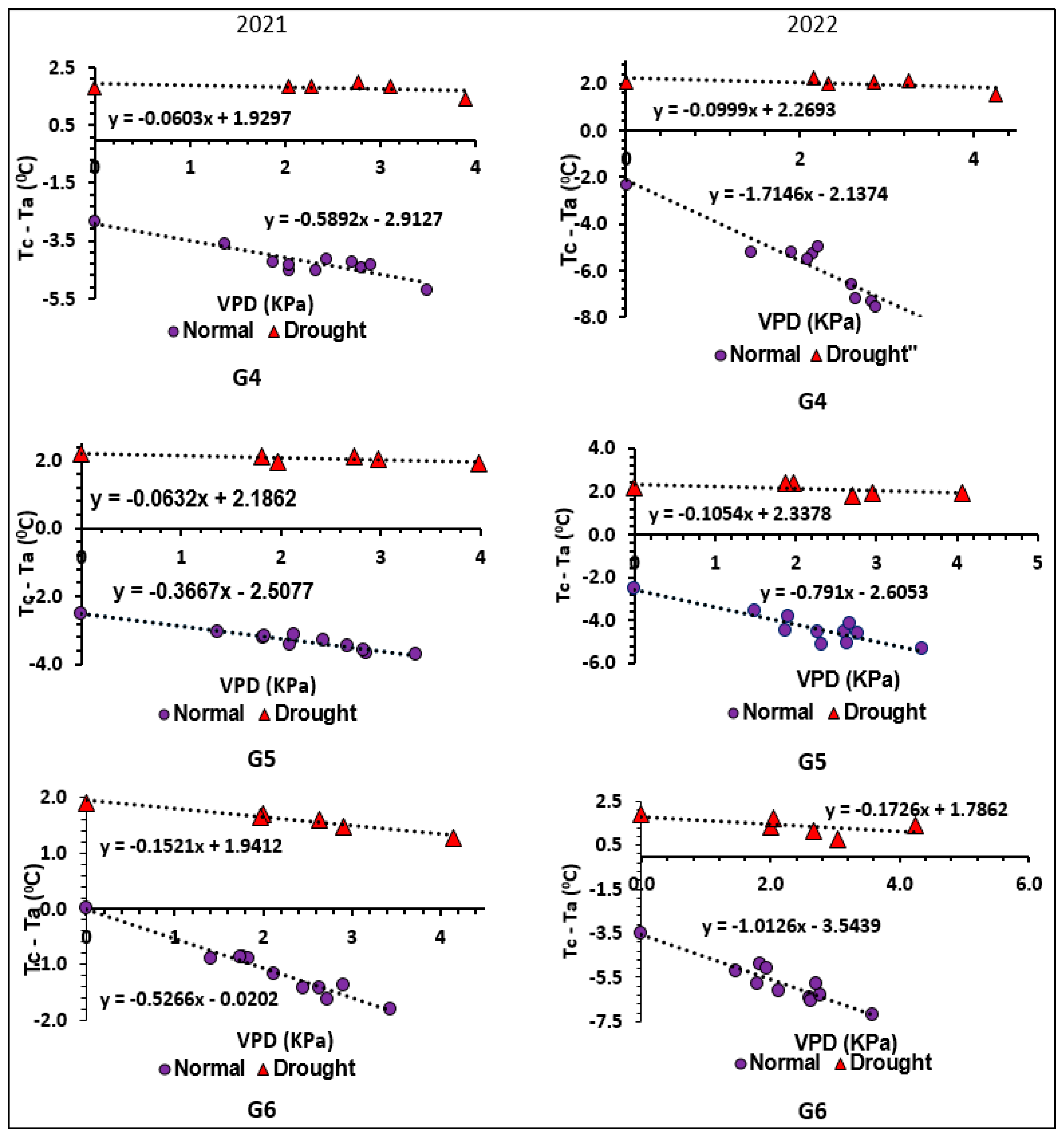
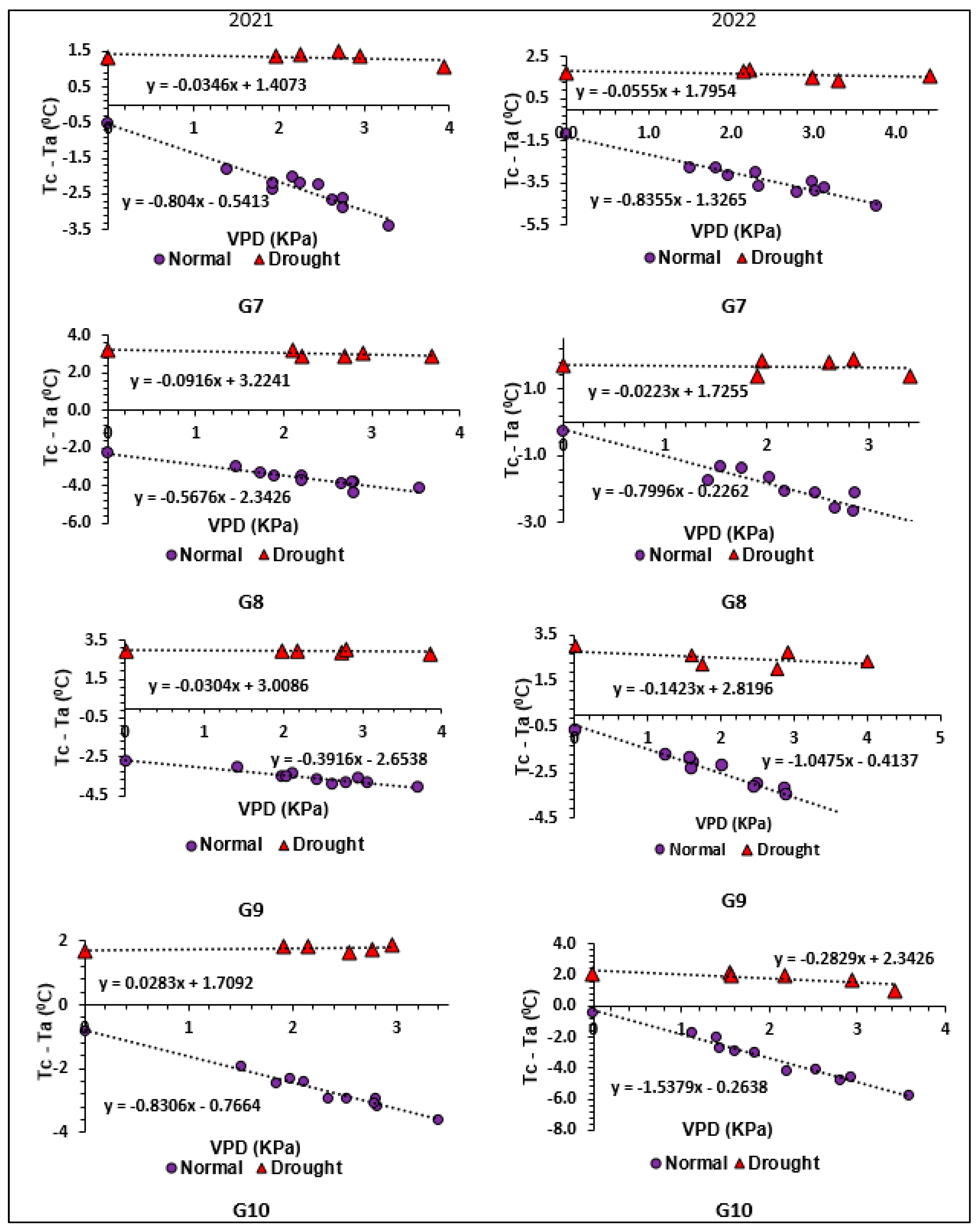
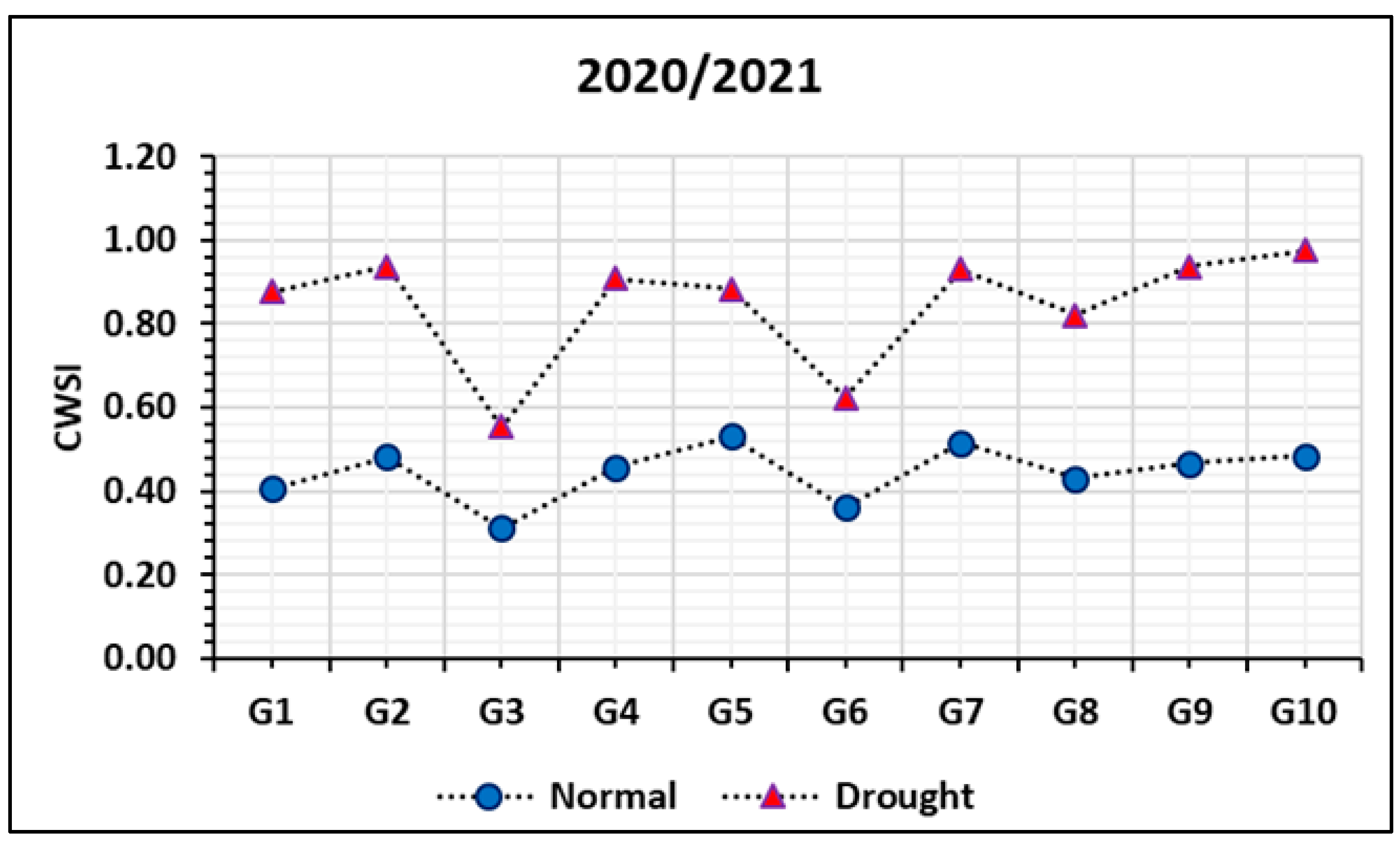
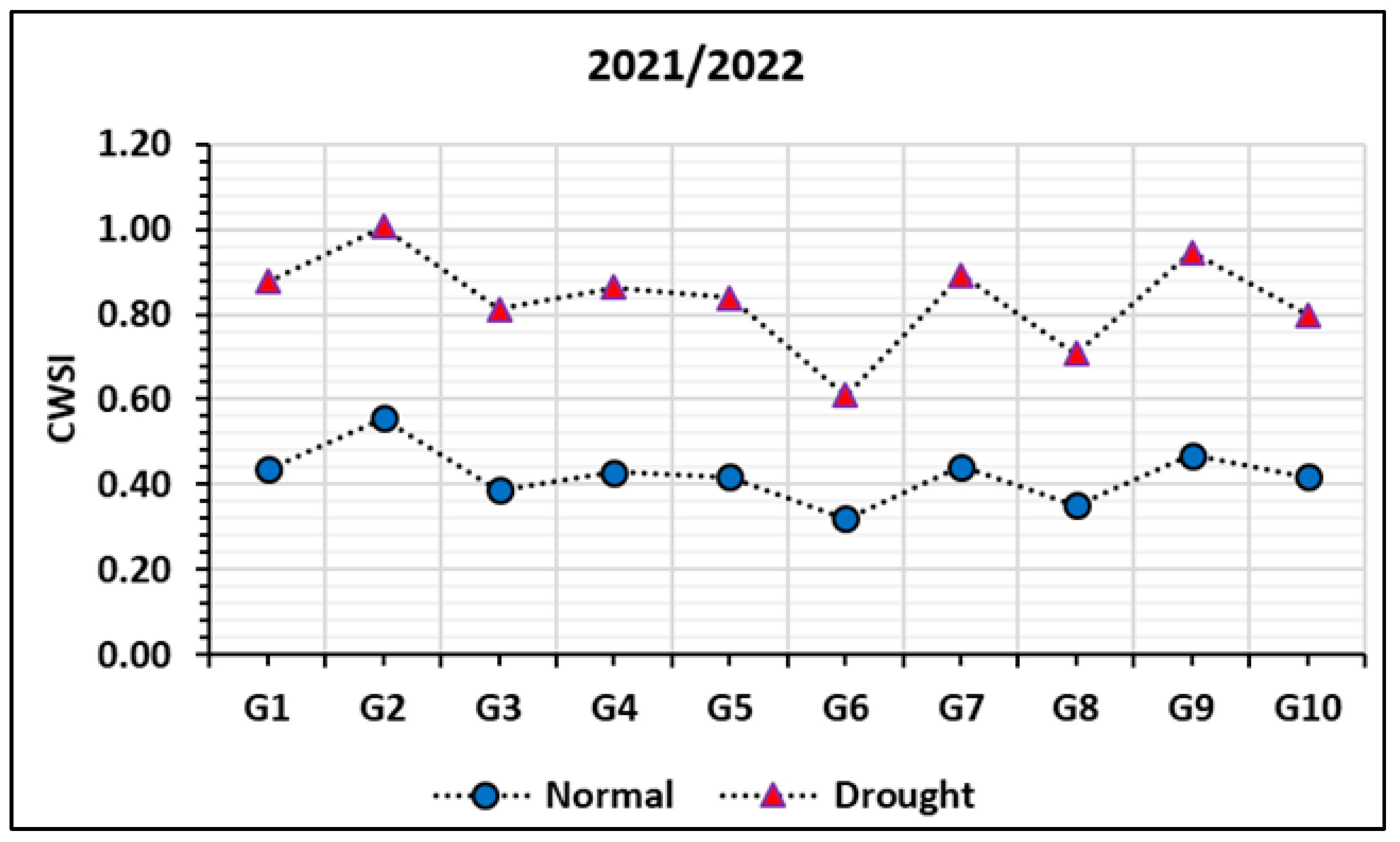

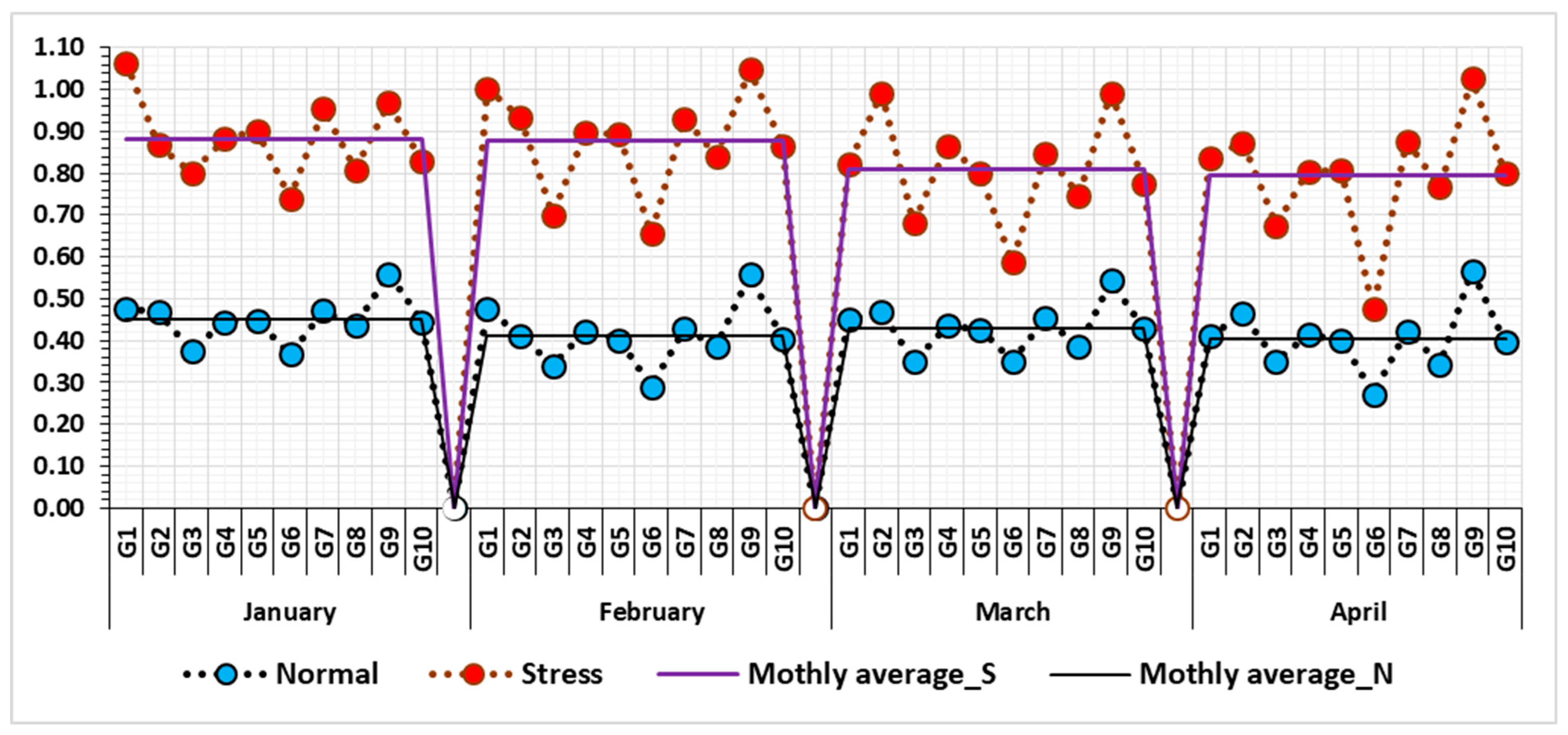
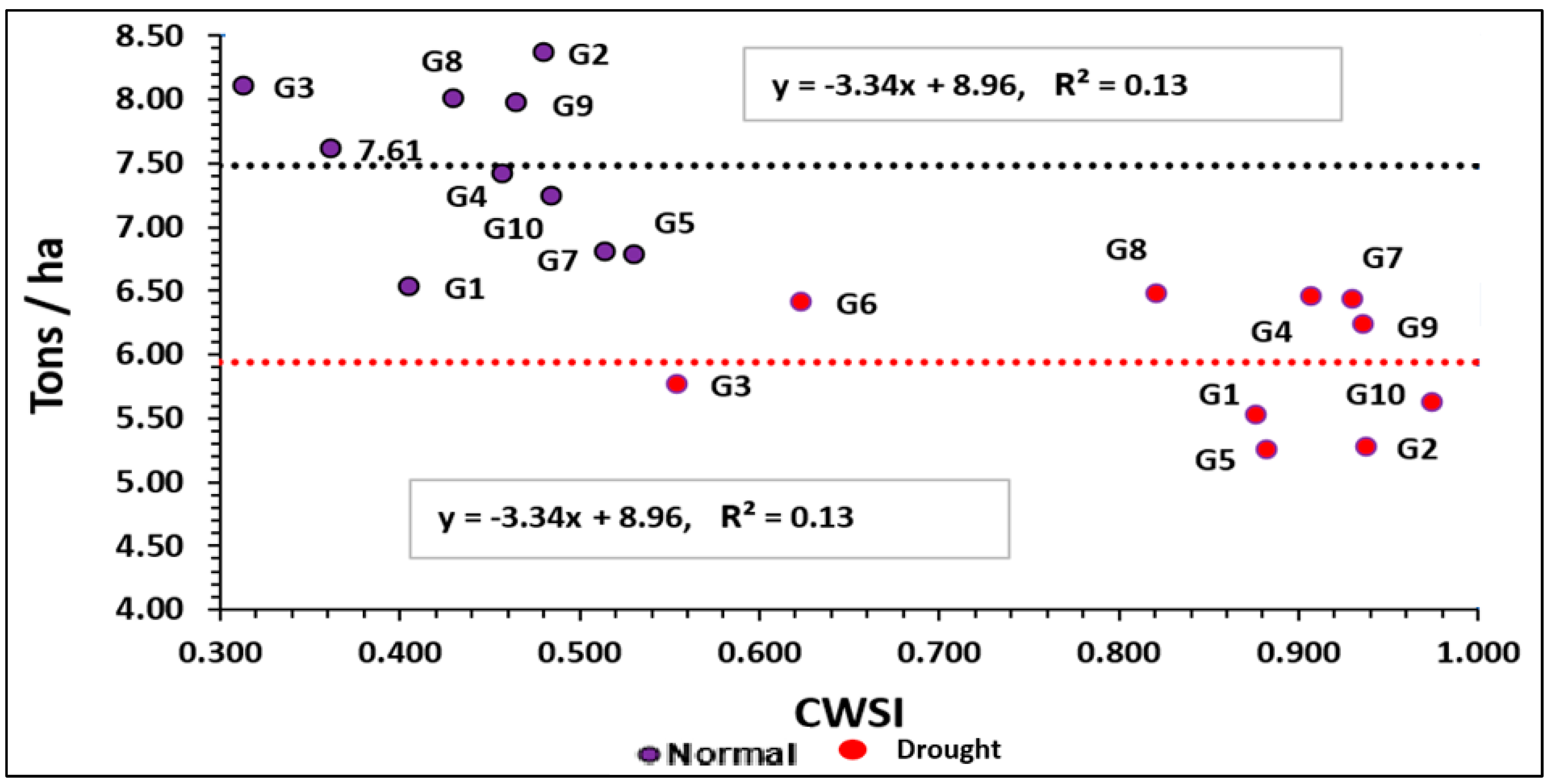
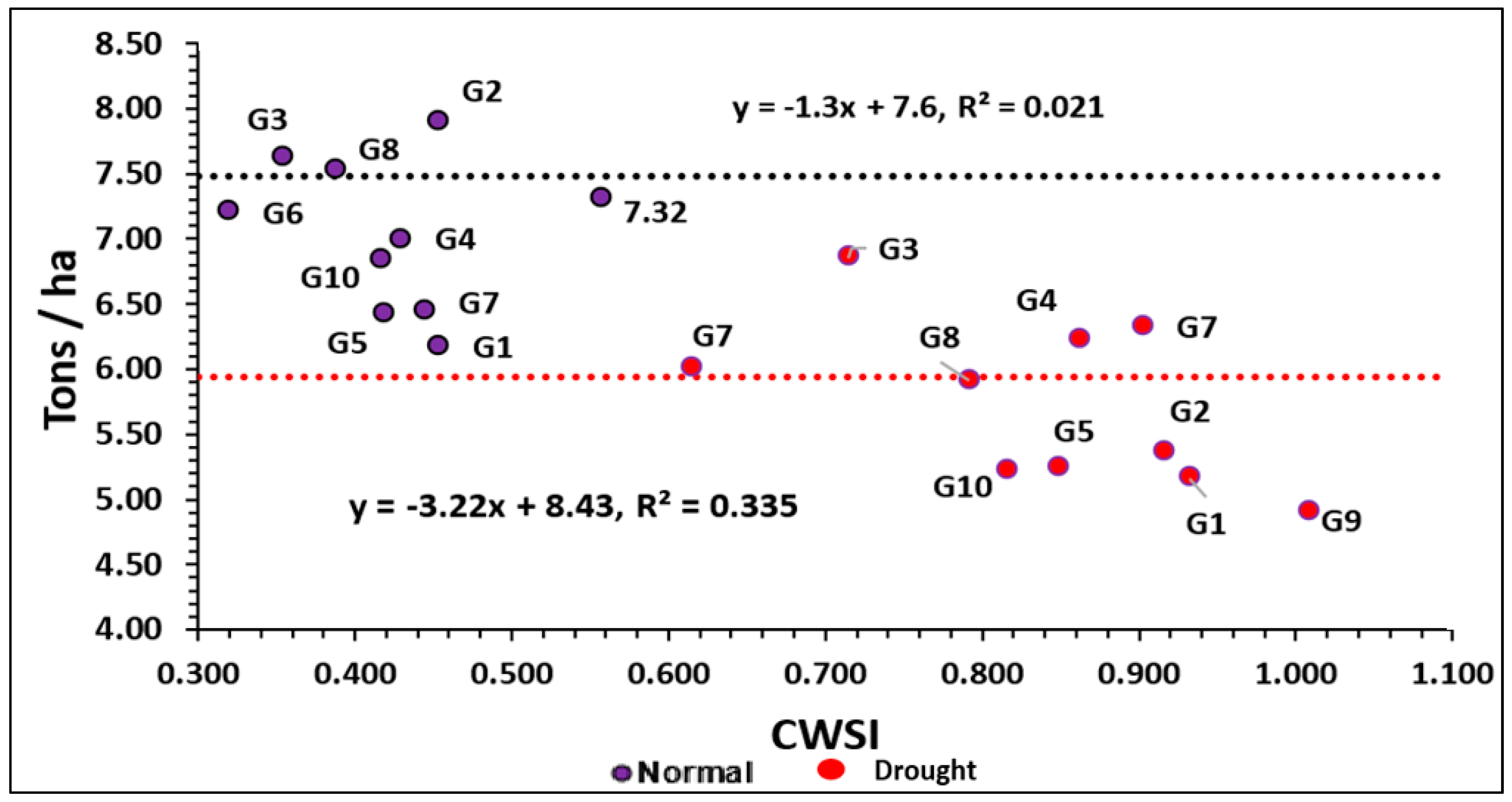

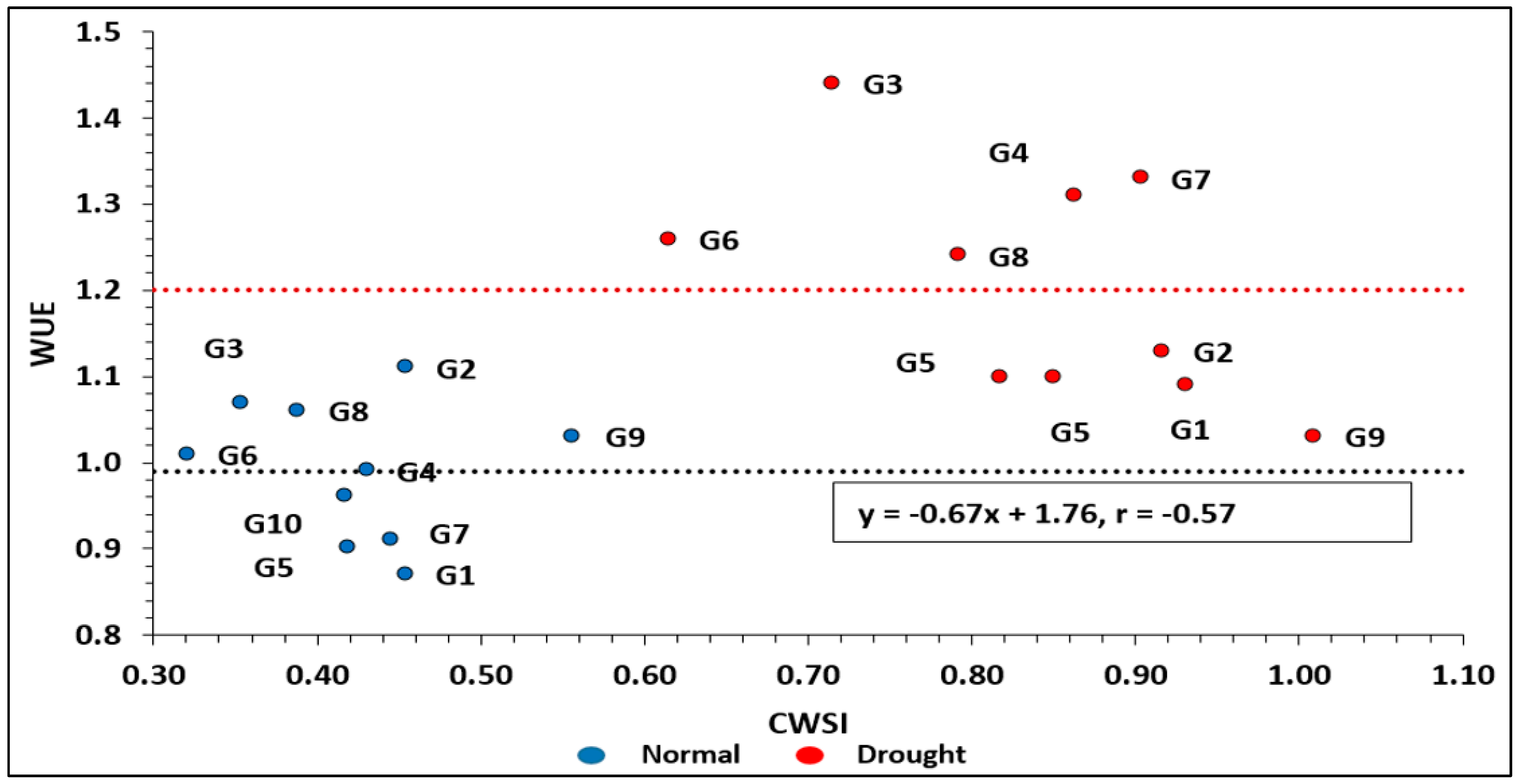
| Season | Measurement | Months | |||||
|---|---|---|---|---|---|---|---|
| November | December | January | February | March | April | ||
| 2020/2021 | Max. Temp. (°C) | 27.3 | 22.8 | 21.2 | 24.5 | 28.9 | 32.5 |
| Min. Temp. (°C) | 20.1 | 15.3 | 13.7 | 16.5 | 20.5 | 24.1 | |
| RH (%) | 58.0 | 63.0 | 65.0 | 64.0 | 51.0 | 37.0 | |
| WS (m/s) | 1.6 | 1.4 | 1.3 | 1.6 | 1.9 | 1.9 | |
| DS (hours/day) | 9.3 | 9.0 | 8.9 | 9.8 | 9.9 | 10.3 | |
| ETo (mm/day) | 3.4 | 2.5 | 2.4 | 3.4 | 5.0 | 6.3 | |
| 2021/2022 | Max. Temp. (°C) | 28.0 | 23.4 | 21.7 | 25.1 | 29.6 | 33.3 |
| Min. Temp. (°C) | 20.6 | 15.7 | 14.1 | 16.9 | 21.0 | 24.7 | |
| RH (%) | 59.5 | 64.6 | 66.7 | 65.6 | 52.3 | 37.9 | |
| WS (m/s) | 1.6 | 1.4 | 1.3 | 1.6 | 1.9 | 1.9 | |
| DS (hours/day) | 9.5 | 9.2 | 9.1 | 10.1 | 10.2 | 10.6 | |
| ETo (mm/day) | 3.5 | 2.6 | 2.5 | 3.5 | 5.1 | 6.4 | |
| Physical Properties | |||||||
|---|---|---|---|---|---|---|---|
| Depth (cm) | Bulk Density (g cm−3) | Field Capacity (%) | Soil Texture | Permanent Wilting Point (%) | Available Water (%) | ||
| 0–30 | 1.4 | 25 | Sandy clay loam | 9 | 16 | ||
| 30–45 | 1.5 | 13 | Sandy loam | 6 | 7 | ||
| Chemical properties | |||||||
| Depth (cm) | pH | ECe (dS m−1) | Available Nutrients (mg kg−1) | CaCO3 % | Organic Matter % | ||
| N | P | K | |||||
| 0–30 | 8.2 | 2.1 | 52 | 15 | 68 | 2.7 | 0.77 |
| 30–45 | 8.5 | 2.4 | 35 | 10 | 41 | 3.7 | 0.51 |
| Genotype | 2020/2021 | 2021/2022 |
|---|---|---|
| G1 | Tc − Ta = −0.9879 VPD − 1.9079 | Tc – Ta = −0.8407 VPD − 1.3825 |
| G2 | Tc − Ta = −0.3787 VPD − 1.176 | Tc − Ta = −1.0184 VPD − 2.0759 |
| G3 | Tc − Ta = −1.446 VPD + 0.0666 | Tc − Ta = −2.1018VPD − 1.6837 |
| G4 | Tc − Ta = −0.5892VPD − 2.9127 | Tc − Ta = −1.7146VPD − 2.1374 |
| G5 | Tc − Ta = −0.3667VPD − 2.5077 | Tc − Ta = −0.791VPD − 2.6053 |
| G6 | Tc − Ta = −0.5266VPD − 0.0202 | Tc − Ta = −1.0126VPD − 3.5439 |
| G7 | Tc − Ta = −0.804VPD − 0.5413 | Tc − Ta = −0.8355VPD − 1.3265 |
| G8 | Tc − Ta = −0.5676VPD − 2.3426 | Tc − Ta = −0.7996VPD − 0.2262 |
| G9 | Tc − Ta = −0.3916VPD − 2.6538 | Tc − Ta = −1.0475VPD − 0.4137 |
| G10 | Tc − Ta = −0.8306VPD − 0.7664 | Tc − Ta = −1.5379VPD − 0.2638 |
| Genotype | 2020/2021 | 2021/2022 | ||||||
|---|---|---|---|---|---|---|---|---|
| Well | Stress | Well | Stress | |||||
| Before | After | Before | After | Before | After | Before | After | |
| G1 | 0.406 | 0.005 | 0.877 | 0.034 | 0.436 | 0.006 | 0.877 | 0.043 |
| G2 | 0.481 | −0.002 | 0.938 | 0.026 | 0.388 | −0.001 | 0.813 | 0.027 |
| G3 | 0.313 | 0.005 | 0.554 | 0.015 | 0.556 | −0.003 | 1.006 | 0.058 |
| G4 | 0.458 | 0.020 | 0.908 | 0.034 | 0.430 | −0.004 | 0.864 | 0.057 |
| G5 | 0.531 | 0.000 | 0.883 | 0.016 | 0.418 | 0.004 | 0.840 | 0.041 |
| G6 | 0.362 | −0.007 | 0.624 | 0.031 | 0.418 | 0.000 | 0.798 | 0.043 |
| G7 | 0.515 | 0.000 | 0.931 | 0.035 | 0.444 | −0.001 | 0.892 | 0.048 |
| G8 | 0.430 | −0.002 | 0.821 | 0.018 | 0.471 | 0.002 | 0.946 | 0.055 |
| G9 | 0.466 | 0.000 | 0.936 | 0.022 | 0.352 | 0.001 | 0.708 | 0.041 |
| G10 | 0.485 | 0.001 | 0.975 | 0.030 | 0.320 | −0.003 | 0.609 | 0.033 |
Disclaimer/Publisher’s Note: The statements, opinions and data contained in all publications are solely those of the individual author(s) and contributor(s) and not of MDPI and/or the editor(s). MDPI and/or the editor(s) disclaim responsibility for any injury to people or property resulting from any ideas, methods, instructions or products referred to in the content. |
© 2024 by the authors. Licensee MDPI, Basel, Switzerland. This article is an open access article distributed under the terms and conditions of the Creative Commons Attribution (CC BY) license (https://creativecommons.org/licenses/by/4.0/).
Share and Cite
Mohamed, N.E.; Mustafa, A.-r.A.; Bedawy, I.M.A.; Ahmed, A.s.; Abdelsamie, E.A.; Mohamed, E.S.; Rebouh, N.Y.; Shokr, M.S. Utilizing Infrared Thermometry to Assess the Crop Water Stress Index of Wheat Genotypes in Arid Regions under Varying Irrigation Regimes. Agronomy 2024, 14, 1814. https://doi.org/10.3390/agronomy14081814
Mohamed NE, Mustafa A-rA, Bedawy IMA, Ahmed As, Abdelsamie EA, Mohamed ES, Rebouh NY, Shokr MS. Utilizing Infrared Thermometry to Assess the Crop Water Stress Index of Wheat Genotypes in Arid Regions under Varying Irrigation Regimes. Agronomy. 2024; 14(8):1814. https://doi.org/10.3390/agronomy14081814
Chicago/Turabian StyleMohamed, Naheif E., Abdel-rahman A. Mustafa, Ismail M. A. Bedawy, Aliaa saad Ahmed, Elsayed A. Abdelsamie, Elsayed Said Mohamed, Nazih Y. Rebouh, and Mohamed S. Shokr. 2024. "Utilizing Infrared Thermometry to Assess the Crop Water Stress Index of Wheat Genotypes in Arid Regions under Varying Irrigation Regimes" Agronomy 14, no. 8: 1814. https://doi.org/10.3390/agronomy14081814








